World War I had shown the importance of operating aircraft with the battlefleet, and all of the major navies continued to work on this integration in the postwar years. While the aircraft carrier was obviously the best way to take planes to sea, it wasn't seen as completely sufficient, and battleships continued to play host to aviation detachments, although the operating methods changed dramatically.
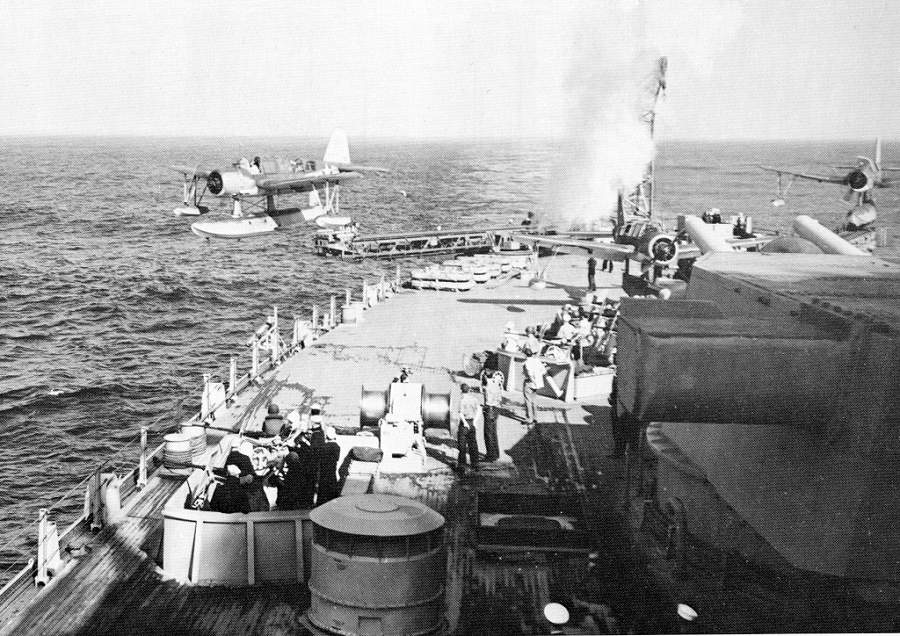
An OS2U Kingfisher is catapulted off of Iowa
There were two main problems with the methods used to take aircraft to sea in WWI. First, the flying-off platforms were limited to fairly light airplanes with a low stall speed, and it was obvious that the future of aviation was in heavier planes with higher speeds, including stall speeds. Second, ditching the airplane in the sea after every sortie was obviously impractical in peacetime, and dubious even in a war where the fleet might be operating far from its bases. The obvious solution to the second was the seaplane, an airplane fitted with floats so it could take off from and land on the water.1 This was obviously not a novel idea, but attempts to use seaplanes during the war had been flummoxed by fragility, vulnerability to sea conditions and lack of performance compared to land planes. Improvements in aeronautical engineering had helped mitigate the first two problems, while the third was largely solved by changes in tactical doctrine. With the development of the aircraft carrier, the roles that required high performance could now be filled by carrier-based aircraft not penalized by floats, leaving seaplanes to fill a few specialized niches. The most important of these were scouting and spotting for the battle line. The airplane offered the fleet commander an opportunity to expand his view of the battlefield far beyond the horizon, and placing the scouts on the battleships freed up space on the carriers for fighters and bombers. The ability to deliver a man with a radio to arbitrary points was also seen as a useful way of overcoming the problems posed to fire control by increasing battle ranges. The spotter could call back corrections to the ship's fire, which might also allow ships to engage in conditions where visibility from the surface was poor, due to either weather or manmade smoke.
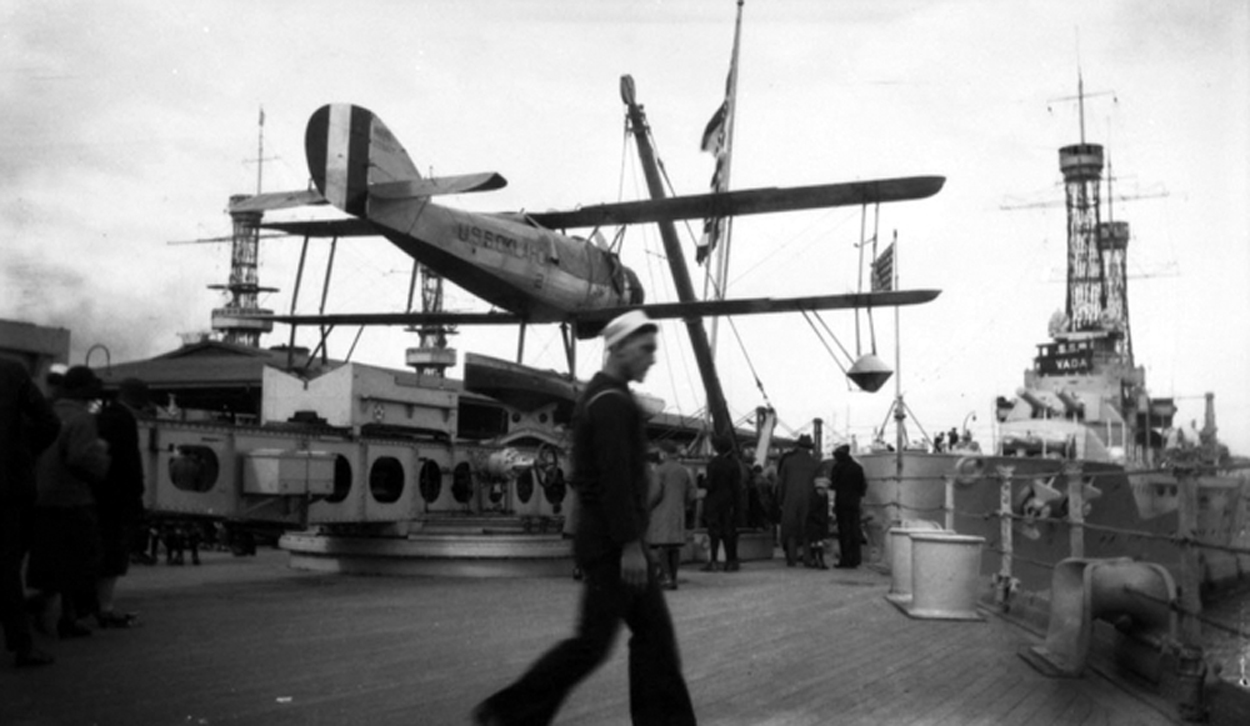
A Vought OU on Oklahoma's catapult, 1925
The biggest problem with these plans was getting the seaplane airborne in the first place. While it was theoretically possible to crane the airplane over the side and have it take off from the surface of the water, this procedure had a number of drawbacks. Landing on the water was lower-energy and thus less risky than takeoff, and the ship had to come to a stop and crane the airplane over the side. The obvious solution was to build a catapult to essentially throw the airplane fast enough for its wings to catch the air, and the first experiment with such a device had in fact been made in 1912. The device, powered by compressed air, nearly killed the first pilot to take off from it. The airplane was merely resting on the catapult, and the sudden acceleration pushed the nose up too quickly, causing it to stall and crash. A successful launch was made a few months later, this time with the catapult modified to hold the airplane until the end of the stroke.
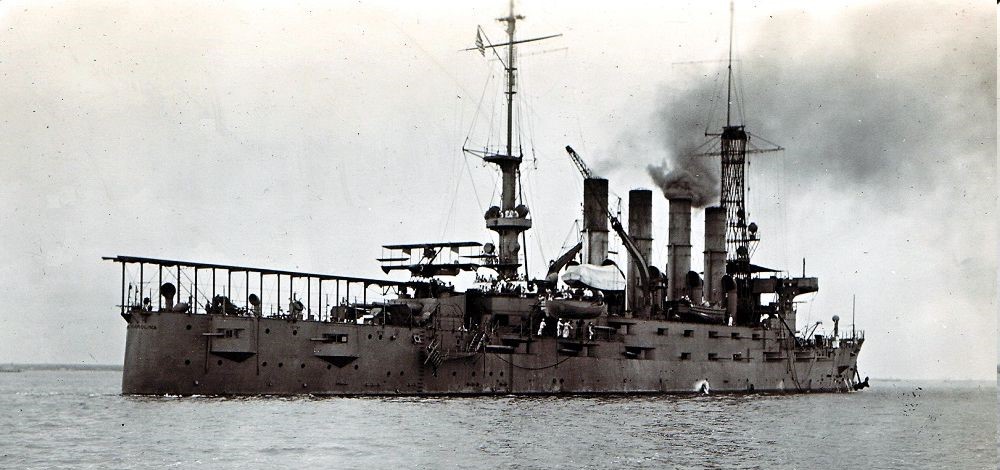
A very early catapult onboard the cruiser North Carolina
The USN continued to be very interested in catapults, and in 1915, one was fitted to the armored cruiser North Carolina, which made the first catapult launch of an airplane from a moving ship. However, this catapult was fixed in place and so long that it had to be routed above the aft turret, badly obstructing it. Because of this, and because the catapult couldn't take advantage of wind or the ship's movement, it was removed when the US entered the war, and American ships serving with the Grand Fleet received flying-off platforms instead.
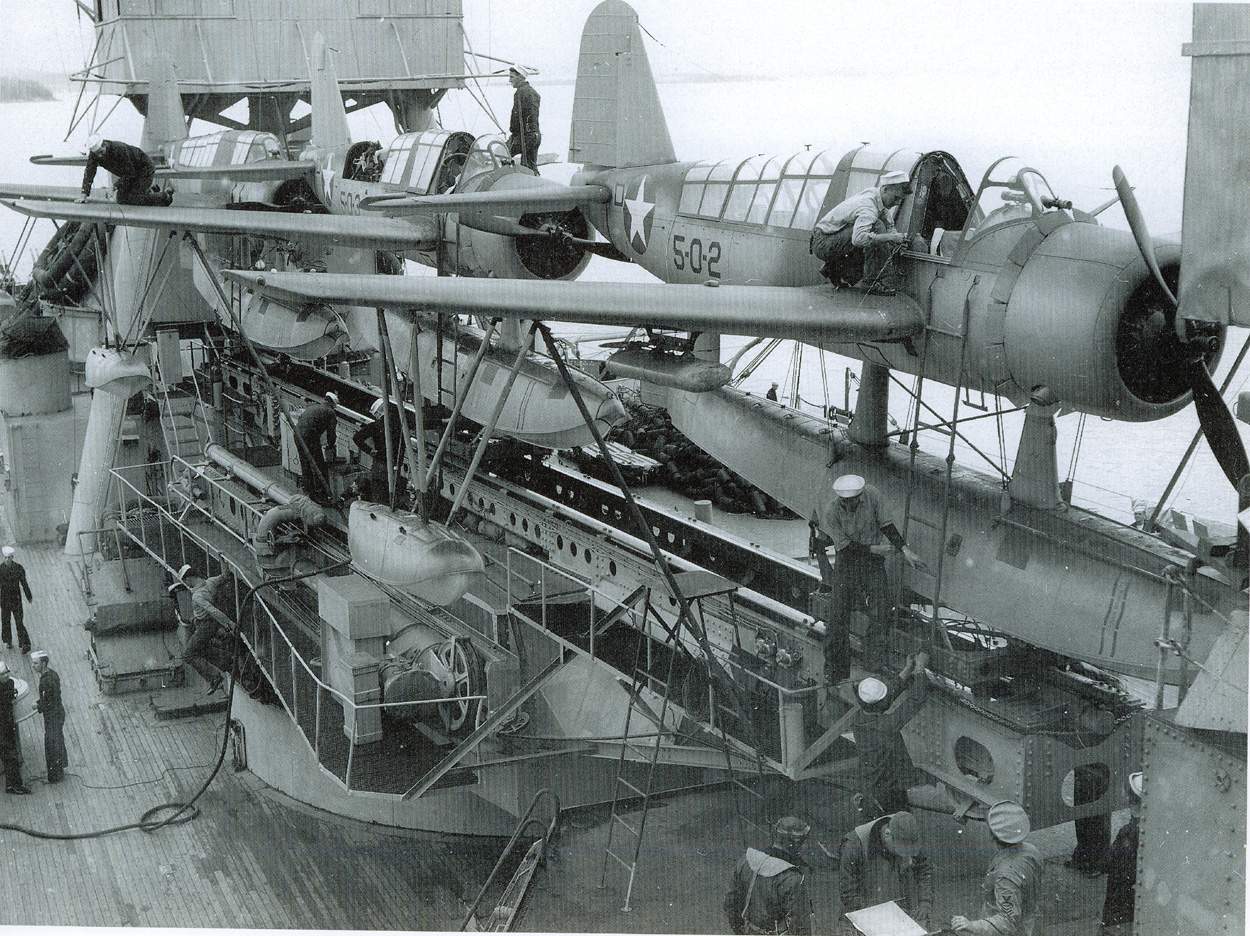
Three Kingfishers on New York's catapult
After the war, navies around the world began to look more seriously at catapults. Compressed air was the power source of choice for the early catapults, although electrical and hydraulic catapults were also developed. Many of these used a relatively short stroke, running through a series of pulleys and wires that meant the airplane traveled much further. However, they were still large and awkward, which made them difficult to fit on turntables. The USN solved this problem in the early 1920s, when it introduced the powder catapult. This was essentially a giant gun, with the airplane attached to the "bullet" and a special charge of slow-burning powder to hurl it down the track. It had the advantage of simplicity, discarding all of the complex hoses, compressors, pumps and the like for what was essentially a 5" blank, filled with the correct amount of powder for the weight of the aircraft being launched. Because of this, powder catapults quickly became the standard worldwide.2
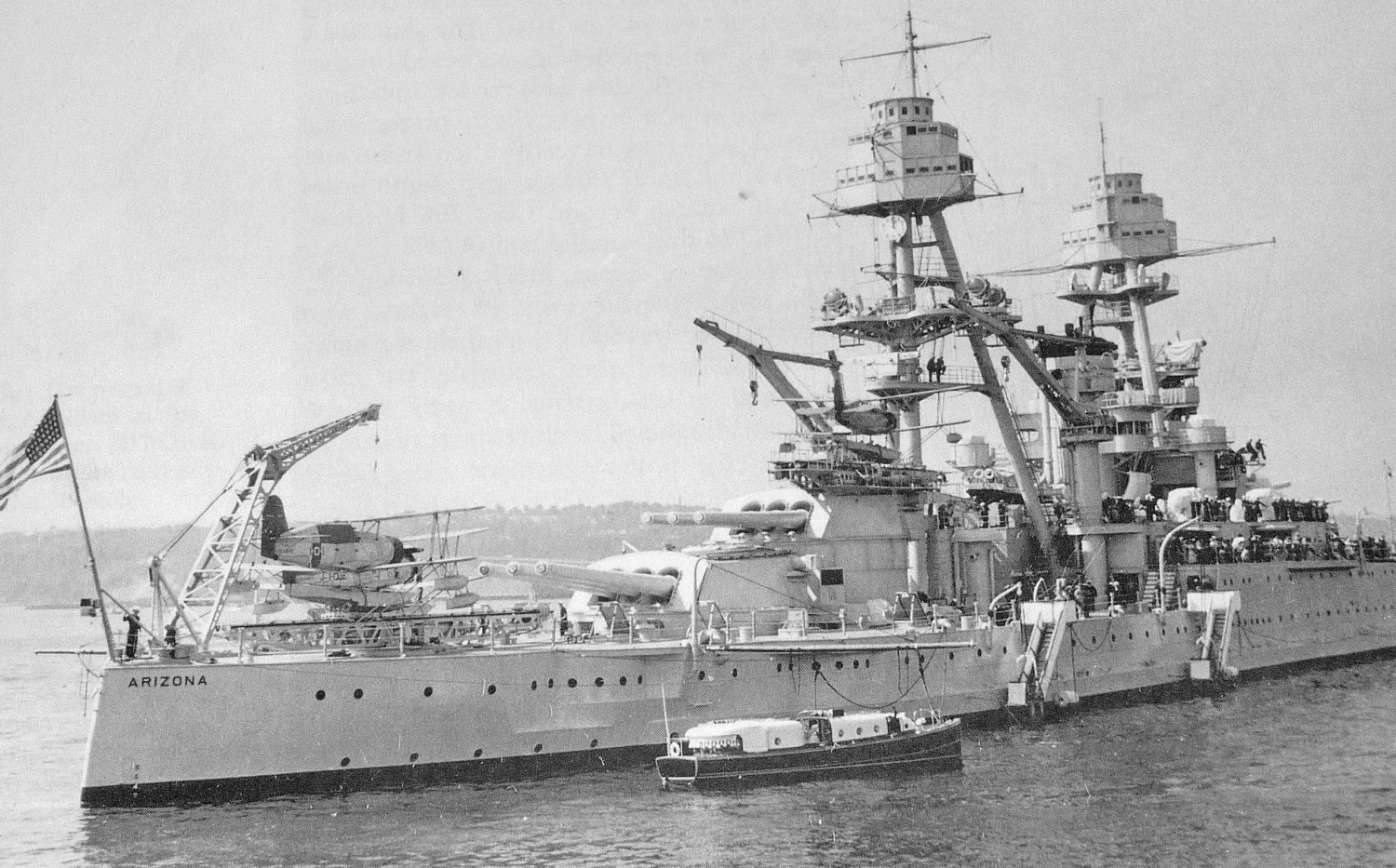
Arizona displaying both turret-top and quarterdeck catapults
But this still left the question of where to mount the catapults. There were three main options. First, some ships had catapults mounted in the traditional position on top of the turrets. This saved deck space and gave the ship a free turntable, but the aviation facilities had to avoid interfering with the turret, which made even something like installing a compressed-air catapult difficult because the air lines couldn't run through the turret. The second option was to place the aviation facilities on the quarterdeck, at the stern of the ship. This was one of the largest open areas on the ship, which made it easy to fit a turntable catapult or two at a fairly minimal cost in weight. However, the airplanes had to be left either on the catapults or on the open deck, exposing them to wind and wave, and American battleships, the primary users of this system, often lost planes in really bad storms.3 The last option was to fit the aircraft facilities amidships, either a pair of turntable catapults or a single fixed catapult mounted across the deck. Either method gave easy access to hangars in the ship's superstructure, where the aircraft could be protected, but also consumed a great deal of valuable space in the middle of the ship. The RN used cross-deck catapults extensively, because it planned to operate its ships in the stormy North Atlantic instead of the relatively placid Pacific, but also because it placed much more emphasis on catapult aviation than the USN did.
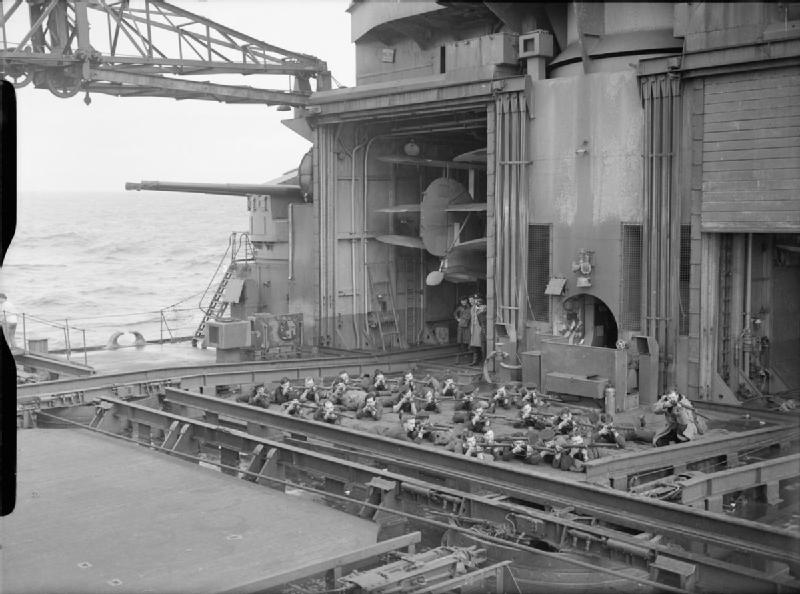
A crossdeck catapult on King George V, with the tail of a Supermarine Walrus showing from the hangar
In the interwar years, the RN, facing a shortage of carrier deck space,4 believed that catapult-launched aircraft could be a valuable addition to the fleet's airpower. As a result, all British naval aircraft were designed to accept floats and a catapult trolley until the late 30s, and a battleship was expected to carry not only spotting/observation planes but also attack aircraft, such as the TSR Swordfish.5 The USN's aviation community had pushed for a similar arrangement, including midships catapults and hangars, but the American designers had rejected this, and gone with the low-impact quarterdeck aviation facilities. Given the price they had paid for these facilities,6 it was rather ironic that the British abandoned battleship aviation entirely by 1944, replacing the catapults with boat storage and turning the hangars into living space, offices, and even a cinema. The USN continued to operate seaplanes through the end of the war for gunfire spotting, antisubmarine patrols, and a new role, search and rescue of downed airmen. Many downed Americans were plucked from under the nose of Japanese-held strongholds by the Kingfishers and Seahawks.
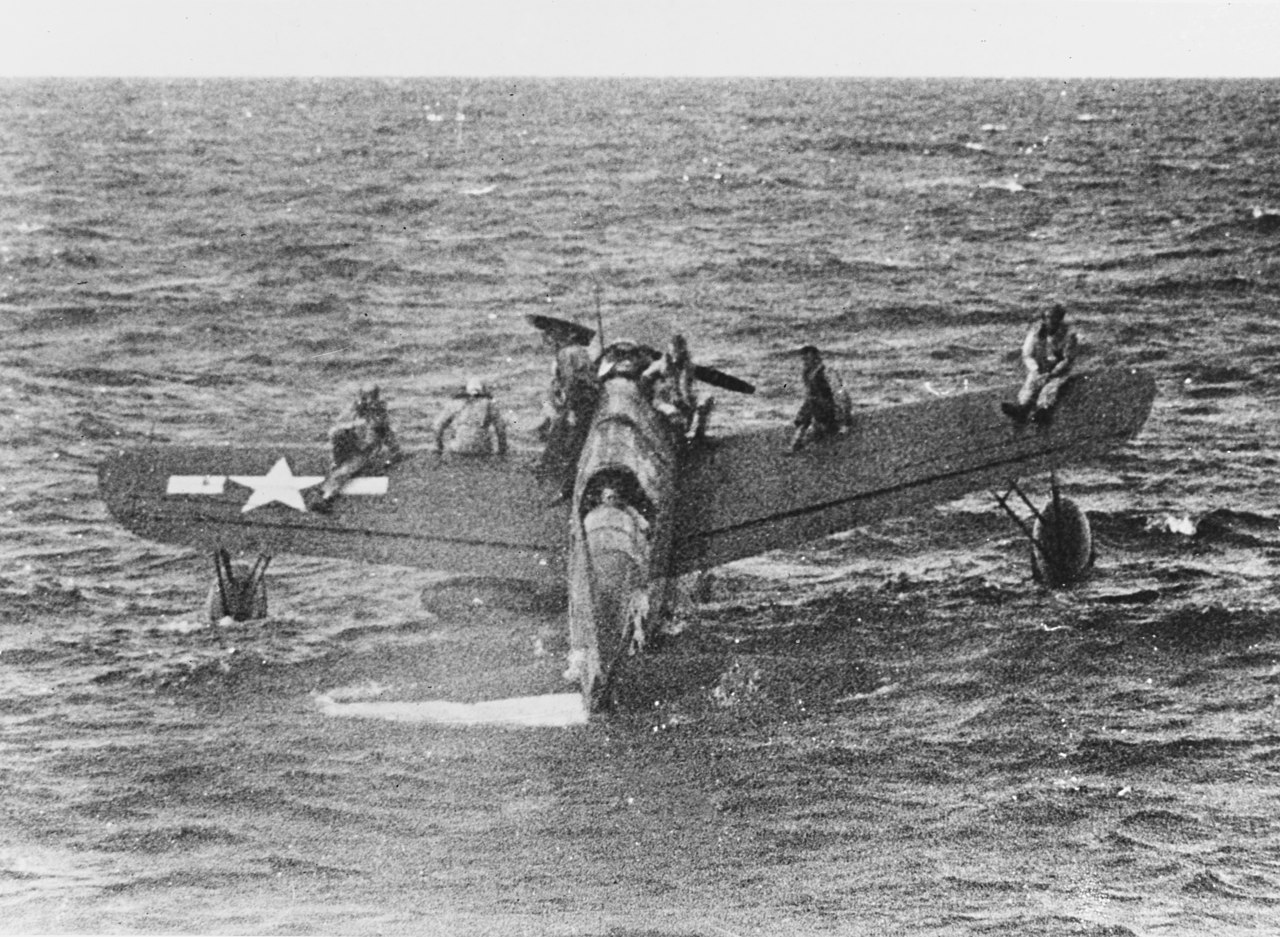
Burns' Kingfisher with passengers
The most famous of these rescues was carried out by LT(JG) John Burns, flying from North Carolina. During air strikes on Truk, another Kingfisher had landed to pick up a pilot, but a gust of wind had flipped the aircraft. Burns landed in five-foot seas and picked up both the shot-down pilot and both Kingfisher crewmen, then offloaded them to the submarine Tang.7 Burns took off and swiftly located more rafts, but when Tang was delayed, he set his airplane down again, and took aboard another six aviators. There was no way to take off with such a load, and by the time Tang reached Burns, the pounding waves had done enough damage to the Kingfisher that Burns and his radioman had to join their passengers aboard the submarine. For his actions, Burns received the Navy Cross, the second-highest award for valor.
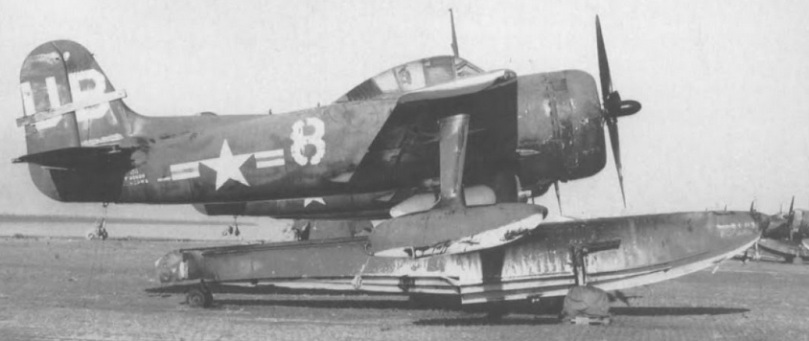
The Seahawk that made the last flight from Iowa8
After the end of the war, seaplanes rapidly disappeared from the world's fleets. The Iowas kept theirs the longest, with Missouri ceasing regular operations in February 1949, and Iowa flying her SC Seahawks ashore in March, the last ever catapult flights of manned aircraft from a battleship. Helicopters were more useful and easier to operate, and I'll discuss their history from battleships in a later post. First, however, it's worth taking a closer look at the mechanics of flying seaplanes from a battleship.
1 Strictly speaking, this is a "floatplane", as contrasted with the flying boat, which used its fuselage for flotation instead. In general, battleships carried floatplanes instead of flying boats, although there were a few exceptions, most notably the Supermarine Walrus. I'm going to use "seaplane" throughout for the sake of simplicity. ⇑
2 It should be pointed out that carrier catapults differed considerably from those used aboard battleships and cruisers. The carrier would turn into the wind, so the catapult could be fixed, which removed some of the volume constraints. This meant that carriers usually used hydraulic catapults for safety reasons, although powder catapults were investigated after WWII when the limits of hydraulic catapults were reached, before being displaced by the steam catapult. ⇑
3 This method didn't completely rule out the use of a hangar. Most US cruisers had a pair of stern catapults and a hangar underneath the quarterdeck, intended to free up space amidships for secondary guns. However, battleships were not fitted with similar hangars. There were other drawbacks to this approach, notably hangar doors that often leaked and a big volume aft that was vulnerable to flooding. ⇑
4 A lot of this was because the RN refused to leave airplanes permanently on a carrier's deck as the USN did, which meant they could fit fewer planes on each carrier. Some of it was also because they had ended up with a lot of fairly small carriers, while the USN's were bigger and more capable. ⇑
5 TSR stood for Torpedo Spotting Reconnaissance in this case, but this lead to a joke in the 60s that the TSR-2 was the successor to the Swordfish. ⇑
6 During design of the King George V class, it was said that the aviation facilities cost about as much as another turret. I've looked into this more, and find it very dubious. Excluding the barbette, the twin 14" turret on the KGV weighed 915 tons, while the entire "equipment" heading for the ship was 1150 tons. More than that, the very similar aviation facilities aboard Belfast were said to weigh 190 tons by Friedman, and similar numbers have turned up in other books. I can't figure out what was going on, but am comfortable rejecting that as untrue. ⇑
7 Submarines were often used as lifeguards during carrier strikes, the most famous beneficiary of this service being George H. W. Bush. ⇑
8 Photo from the fabulous article on catapult aviation at WWII After WWII. ⇑

Comments
Again, great topic Bean with obvious research and some great nuggets - such as seaplanes being launched from battleships up to 1949. I had no idea.
I particulary like that picture of the Arizona. Not sure what those two guys far aft are sitting on, but they look to be high up and not harnessed. Not afraid of heights to be sure!
What really strikes me though are the housings well up on the two masts. What was in them? Must have been one violent ride in very heavy and disturbed seas.
Thanks, Neal. This was a fun one to write.
Those guys are actually within the safety railing. This isn't particularly visible in the reduced version I used, but it shows up in the original.
And the enclosures at the top of the mast were for fire control. It wasn't as bad as you might think. Battleships were big enough to be pretty smooth in all but really bad weather, and that usually gives you other things to worry about.
This is a great topic as always. I sort of hate you for exposing me to WWII after WWII, because that's an unexpected time sink about things that I didn't know I wanted to know about.
I can see the rail that the sailors in the Arizona picture are sitting in, but it wouldn't surprise me if they weren't behind any safety barrier. It's actually sort of amazing how cavalier people used to be about such things. I was discussing the construction of the second stage of the Bonneville Dam 1st Powerhouse with a coworker (mid-WWII, so a little after this picture) and he discussed a picture floating around where they had a near-vertical cut in soil where they were rebuilding the fishways. Something that wouldn't even be considered today! Similar to the pictures you see of ironworkers walking around on beams building skyscrapers, not a tieoff to be seen.
You're not wrong about their attitude to risk. I was recently reading about the Farnborough crash in 52, and the attitude involved strikes me as incredible. 31 people died, and the only change to the program was that the next pilot to go up was asked to keep away from the crowds a bit. The contrast to the reaction over Shoreham is interesting, to say the least.
Churchill was very annoyed about the catapults on the KGV ships taking up a lot of mid-deck space, until the naval architects pointed out to him that the armored citadel was the length it was to protect all the machinery, and so the catapults were taking advantage of that space rather than forcing it to be expanded at the cost of a turret, or ship length, or something else. Not sure about the weight or cost of the facilities, though.
That sounds like a very Churchill story. Him misunderstanding something and wanting to "fix" it long after the relevant decisions had all been taken. (Note that Churchill wasn't at the Admiralty until the outbreak of war, long after the relevant decisions had been made.)
There was a substantial cost, though, specifically in terms of secondary armament and topweight. I wouldn't be at all surprised if they'd been able to keep B turret a quad if they'd scrapped the aviation facilities.